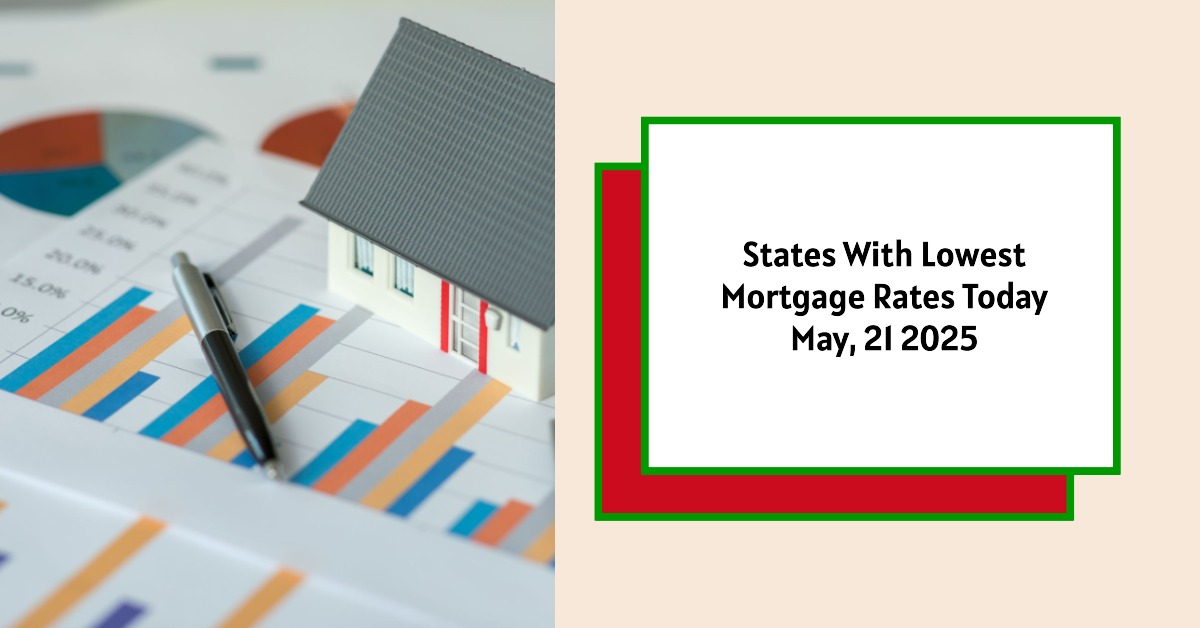Looking for the states with the lowest mortgage rates today, May 21, 2025? You're in the right place. As of today, states with the cheapest 30-year new purchase mortgage rates are New York, California, Florida, Georgia, New Jersey, Texas, and Hawaii, where average rates are hovering between 6.83% and 7.04%. On the other hand, Alaska, West Virginia, Washington, D.C., Iowa, Nevada, North Dakota, Vermont, Delaware, and Wyoming have the most expensive rates, ranging from 7.11% to 7.16%. Let's dive into why these variations exist and what it means for you.
States With Lowest Mortgage Rates Today – May, 21 2025
Why Do Mortgage Rates Vary So Much by State?
It's a valid question, and the answer is multi-layered. Several factors come into play when determining mortgage rates, and these can vary significantly from one state to another. Think of it like this: different states have different economic climates, which impact the risk lenders take on.
Here's a breakdown of the key reasons:
- Lender Presence and Competition: Not all lenders operate in every state. The level of competition among lenders can significantly influence rates. If there are only a few lenders in a state, they might not need to offer the most competitive rates.
- State-Level Regulations: Each state has its own set of rules and regulations regarding mortgage lending. These regulations can impact the cost of doing business for lenders, which they may pass on to borrowers in the form of higher rates.
- Average Credit Scores: States with higher average credit scores generally see lower mortgage rates. Lenders view borrowers with strong credit histories as less risky.
- Average Loan Size: In states where homes are more expensive and loan sizes are larger, lenders might adjust rates to reflect the increased financial exposure.
- Economic Conditions: A state's overall economic health plays a big role. A booming economy might lead to higher demand for housing, potentially pushing rates up.
- Risk Management Strategies: Lenders have different strategies for managing risk. Some lenders might be more aggressive in offering lower rates to attract borrowers, while others might prioritize profitability.
Deep Dive: States With the Lowest Rates
Let's take a closer look at the states currently enjoying the lowest mortgage rates:
- New York: Known for its diverse economy and vibrant real estate market, New York consistently offers competitive mortgage rates. I attribute this to the high volume of transactions and the presence of numerous lenders vying for business.
- California: The Golden State's robust economy and large population create a highly competitive mortgage market. Expect to see diverse lending options and competitive rates, especially in metropolitan areas.
- Florida: With its growing population and attractive real estate market, Florida is a hotbed for mortgage activity. Competition among lenders keeps rates relatively low.
- Georgia: Atlanta's growing economy and affordable housing market have made Georgia a desirable place to live. The increased demand for mortgages has fostered a competitive lending environment.
- New Jersey: Despite its high property taxes, New Jersey maintains competitive mortgage rates, likely due to its proximity to major financial hubs and a stable housing market.
- Texas: The Lone Star State's booming economy and population growth have fueled its real estate market. The resulting competition among lenders contributes to lower mortgage rates.
- Hawaii: Believe it or not, mortgage rates are actually quite cheap in Hawaii. This is due to the stringent lending standards and the high cost of home buying.
States With the Highest Rates: What's Going On?
Now, let's examine the states with the highest mortgage rates:
- Alaska: The Last Frontier often sees higher rates due to its remote location, smaller population, and unique economic conditions. The cost of doing business for lenders is generally higher in Alaska.
- West Virginia: Economic challenges and a smaller housing market can contribute to higher mortgage rates in West Virginia.
- Washington, D.C.: Despite being a major economic hub, the District of Columbia's high property values and dense population can lead to higher rates. I suspect regulations and lender risk assessments also play a role.
- Iowa: A more rural market with a less competitive lending environment may be contributing to slightly elevated rates.
- Nevada: Despite being a major tourist destination, mortgage rates are quite high in Nevada. This is due to high real estate valuations.
- North Dakota: Similar to other sparsely populated states, North Dakota's smaller market and higher operational costs for lenders can lead to higher rates.
- Vermont: Known for its scenic beauty and rural character, Vermont's smaller market and unique housing landscape may result in higher mortgage rates.
- Delaware: Mortgage rates are still quite high in Delaware due to some of the same reasons as the other high-interest states. This is mostly due to the unique economic conditions.
- Wyoming: The last state on the list is Wyoming. Because it's a low-population state, real estate investments are generally less profitable, leading to higher mortgage rates.
It's important to note that “highest” is relative. The difference between the lowest and highest rates we're seeing today is relatively small, but even a fraction of a percentage point can make a big difference over the life of a loan.
National Mortgage Rate Trends: A Broader Perspective
Zooming out, let's look at the national mortgage rate averages. As of today, May 21, 2025:
- The average rate for a 30-year fixed-rate mortgage is 7.05%. This is a slight decrease of 2 basis points compared to yesterday.
- FHA 30-Year Fixed averages 7.37%.
- 15-Year Fixed mortgages are averaging 6.08%.
- Jumbo 30-Year Fixed mortgages are at 7.02%.
- 5/6 ARM loans are averaging 7.23%.
Historical Context:
It’s worth remembering that rates have fluctuated quite a bit recently. Back in March 2025, we saw 30-year rates dip to 6.50%, which was the lowest of the year. And in September of 2024, they hit a two-year low of 5.89%. This volatility highlights the importance of staying informed and being ready to act when rates are favorable.
Read More:
States With the Lowest Mortgage Rates on May 20, 2025
Projected Mortgage Rates for the Week of May 5-11, 2025
When Will Mortgage Rates Go Down from Current Highs in 2025?
Factors Influencing National Rates:
Several macroeconomic factors influence national mortgage rates. These include:
- The Bond Market: The 10-year Treasury yield is a key indicator.
- Federal Reserve Policy: The Fed's monetary policy, including bond buying and funding of government-backed mortgages, significantly impacts rates. Remember the Fed's aggressive rate hikes in 2022 and 2023 to combat inflation?
- Competition: Competition among lenders always plays a role.
Given the number of factors, it's challenging to pinpoint any single cause for rate changes.
How to Find the Best Mortgage Rate for You
Regardless of where you live, there are steps you can take to secure the best possible mortgage rate.
- Shop Around: This is the most important piece of advice I can give. Don't settle for the first offer you receive. Contact multiple lenders – banks, credit unions, and online lenders – to compare rates and terms.
- Improve Your Credit Score: A higher credit score can unlock lower rates. Pay your bills on time, reduce your debt, and check your credit report for errors.
- Increase Your Down Payment: A larger down payment reduces the lender's risk and can result in a lower interest rate.
- Consider Different Loan Types: Explore options like fixed-rate mortgages, adjustable-rate mortgages (ARMs), and FHA loans. Each has its own advantages and disadvantages, so choose the one that best fits your financial situation.
- Be Aware of “Teaser Rates”: Be cautious of advertised rates that seem too good to be true. These “teaser rates” often come with hidden costs or require you to pay points upfront. Remember, the rate you ultimately secure will depend on your individual circumstances.
The Bottom Line:
Navigating the mortgage market can feel overwhelming, but understanding the factors that influence rates and taking proactive steps to improve your financial profile can empower you to make informed decisions. By shopping around, improving your credit score, and exploring different loan options, you can increase your chances of securing a competitive mortgage rate.
Stay informed, stay proactive, and good luck on your home-buying journey!
Invest in Real Estate in the Top U.S. Markets
Investing in turnkey real estate can help you secure consistent returns with fluctuating mortgage rates.
Expand your portfolio confidently, even in a shifting interest rate environment.
Speak with our expert investment counselors (No Obligation):
(800) 611-3060
Also Read:
- Will Mortgage Rates Go Down in 2025: Morgan Stanley's Forecast
- Expect High Mortgage Rates Until 2026: Fannie Mae's 2-Year Forecast
- Mortgage Rate Predictions 2025 from 4 Leading Housing Experts
- Mortgage Rates Forecast for the Next 3 Years: 2025 to 2027
- 30-Year Mortgage Rate Forecast for the Next 5 Years
- 15-Year Mortgage Rate Forecast for the Next 5 Years
- Why Are Mortgage Rates Going Up in 2025: Will Rates Drop?
- Why Are Mortgage Rates So High and Predictions for 2025
- Will Mortgage Rates Ever Be 3% Again in the Future?
- Mortgage Rates Predictions for Next 2 Years
- Mortgage Rate Predictions for Next 5 Years
- Mortgage Rate Predictions: Why 2% and 3% Rates are Out of Reach
- How Lower Mortgage Rates Can Save You Thousands?
- How to Get a Low Mortgage Interest Rate?
- Will Mortgage Rates Ever Be 4% Again?



